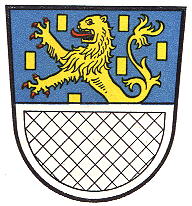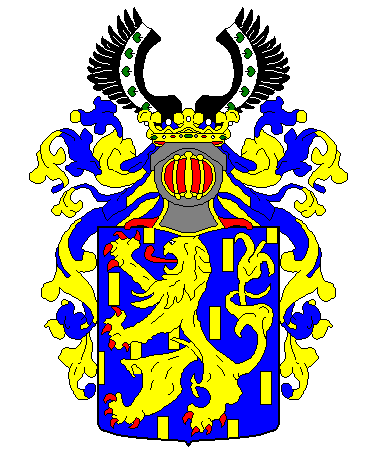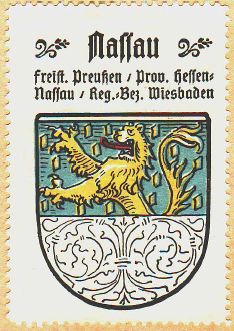Nassau: Difference between revisions
Knorrepoes (talk | contribs) m (Text replace - "'''Official blason:'''<br>" to "====Official blazon====") |
Knorrepoes (talk | contribs) m (Text replace - "'''Origin/meaning :'''<br/>" to "====Origin/meaning====") |
||
| Line 17: | Line 17: | ||
====Origin/meaning==== | |||
The arms were officially granted on ?? | The arms were officially granted on ?? | ||
Revision as of 15:50, 1 April 2012
| Heraldry of the World Civic heraldry of Germany - Deutsche Wappen (Gemeindewappen/Kreiswappen) |
NASSAU
State : Rheinland-Pfalz
District (Kreis) : Rhein-Lahn Kreis (until 1969 Unterlahnkreis)
Verbandsgemeinde : Nassau
Official blazon
Origin/meaning
The arms were officially granted on ??
The lion in the upper part is the arms of the Counts of Nassau, who built their castle in the village around 1100 and who granted the city rights in 1348. To distinguish the arms of the city with the arms of the dynasty, the lower part was made white. This combination is already seen on the oldest, 15th century seal. The arms were officially granted in 1906.
The arms of Nassau are one of the most widely spread arms in Germany, and can be seen in civic heraldry in many other countries. The Nassau dynasty belonged to the highest noble families, with several distinct branches, all with many possessions. One of the branches inherited the principality of Orange in France and this dynasty is still the ruling family of the Netherlands. Another branch is still the ruling family of Luxembourg.
| The oldest arms of the counts of Nassau. |
The arms in the Kaffee Hag albums +/- 1925 |
The lion of Nassau can thus be found in many civic arms in Germany, the Netherlands and some other countries. In Germany for example in the arms of the districts Ottweiler, Kirchheimbolanden, Oberwesterwaldkreis, Wetzlar and the Unterlahnkreis. Also in the arms of many German municipalities, such as Dannenfels, Idstein, Hofheim am Taunus, Ellar, Weilmünster, Weilburg and Usingen to name a few.
Furthermore the lion forms the main part of the Dutch National arms and several municipalities in the Netherlands, such as Dodewaard, Klundert, Sambeek and Boxmeer.
Many Dutch arms (including many now in Belgium) that were granted in the early 19th century have the colours of Nassau. When the original colours were not known the Royal colours were used, i.e. the Nassau colours.
In Luxembourg the lion appears in the arms of Pétange, Weiswampach and the arms of Walferdange are also partly based on the Nassau arms.
Through the dynasty of Nassau-Saarbrücken, the Nassau arms appear in France in Mackwiller and Oermingen.
Finally the arms appear in the arms of Stenschewo in Poland, which was a possession of the Dutch royal family, the seal of Nassau County in Michigan, USA, the seal of Hofstra University (USA), the county of Williamsburg (USA), and the arms of some towns in the former Dutch East Indies (Padang, Palembang and Buitenzorg), now all in Indonesia.
Literature : Stadler, K. : Deutsche Wappen - Bundesrepublik Deutschland. Angelsachsen Verlag, 1964-1971, 8 volumes.



